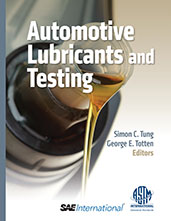Technical Paper
Review of ASTM D-2882 Hardware Problems and Suggested Solutions
1998-09-14
982021
The ASTM test method D-2882 (Standard Test Method for Indicating the Wear Characteristics of Petroleum and Non-Petroleum Hydraulic Fluids in a Constant Volume Vane Pump) is widely used to evaluate hydraulic fluids. Performing this method can be difficult due to problems with the pump hardware and the written procedure. This paper discusses the problems and suggests possible remedies.

